End-Fed Half-Wave & 49:1 Unun
I am a happy user of 1/4 wave verticals and hamsticks, but I’ve been thinking that I should look into another antenna type to add to my bag of tricks when I go out to do a POTA/WWFF activation. The hamsticks are easy to set up and completely avoid dealing with people tripping over wires, but they aren’t as good as full-sized antennas. On the other end of the spectrum, 1/4 wave verticals work really well, but the radial field needs quite a bit of space and curious passers-by have a tendency to walk right through it.
For a long while, I was contemplating building a end-fed half-wave antenna. The draw with this type of antenna is that it has a minimal ground footprint, but it is still a full-sized antenna, so it should perform well.
Before I go any further, I should say that there is a difference between end-fed half-wave and random-wire antennas. End-fed half-waves, as the name suggests, are exactly half a wavelength long. In theory, the feed point has an infinite impedance, but in practice it is between 3 and 4kΩ. As a result, they are often fed with a 49:1 or 64:1 unun which transforms the 50Ω coax feedline impedance to about 2.5–3.2kΩ. Because the impedance is so close, it is possible to use these antennas without a tuner. Random wire antennas are also end-fed, but their length is specifically chosen to be not resonant. They are often fed with a 9:1 unun and require a tuner.
Gathering Info
Before I ordered the parts to build my antenna (or to be more accurate, the 49:1 unun), I looked for information about this type of antenna.
I found K1RF’s slides from 2018 titled The End-Fed Half-Wave Antenna. They seem to cover pretty much everything I wanted to know about the design—namely the ferrite toroid sizing, capacitor specs, and so on.
As far as what to expect from the mechanical build, I drew inspiration from KM1NDY’s DIY 49:1 Unun Impedance Transformer For End-Fed Half Wave (EFWH) Antenna (Step-by-Step Instructions) blog post.
Bill of Materials
I ordered the items I was missing from Mouser. I could have probably saved a few dollars by hunting around on eBay, but I like the idea of receiving what I wanted instead of mis-advertised garbage…and I was going to place an order with them anyway for one of my other hobbies.
Using K1RF’s summary table (see slide 25), I targeted something between “QRP” and “QRP Plus” to make it somewhat portable. I tend to run 50-66W SSB and 15-25W digital, which is certainly on the upper end of the approximate power rating from that slide.
Namely, I went with two T140-43 toroids, 21:3 turns of #20 magnet wire, and 100pF 3kV capacitor. I used #20 magnet wire simply because I already had a spool.
Here’s the list of items for my build including prices (some of which I estimated):
| Item | Qty | Price | |
| Ferrite T140-43 | $2.94 | 2x | $5.88 |
| Capacitor 100pF 3kV | $0.22 | 1x | $0.22 |
| Type-N connector | $8.02 | 1x | $8.02 |
| Magnet wire #20 | ~9’ | ~$1 | |
| Assorted screws, nuts, and washers | ~$2 | ||
| “Project box” | free | ||
| Total | ~$17 |
For comparison, a similarly sized commercially produced 49:1 unun will easily cost between $30 and $60.
I used my favorite source for project boxes—a nearby restaurant. Many restaurants use various plastic boxes for take out orders. I love using these for various projects. Since they don’t cost me anything, I don’t care if I break it during construction or scrape it up during subsequent use.
(And yes, I’m aware, type-N connectors aren’t necessary for HF. I standardized on them to allow me to use the same coaxes for whatever band I wish without having to worry about adapters or losses.)
Bench Testing
After the build was done, I soldered a 2.2kΩ and a 1kΩ resistor in series to use as a 1/4W dummy load for the NanoVNA. I didn’t bother doing anything fancy with the “dummy load”. I simply let it rest between the antenna terminal and the ground on the connector:
Anyway, here’s the VNA sweep from 1 MHz to 30 MHz:
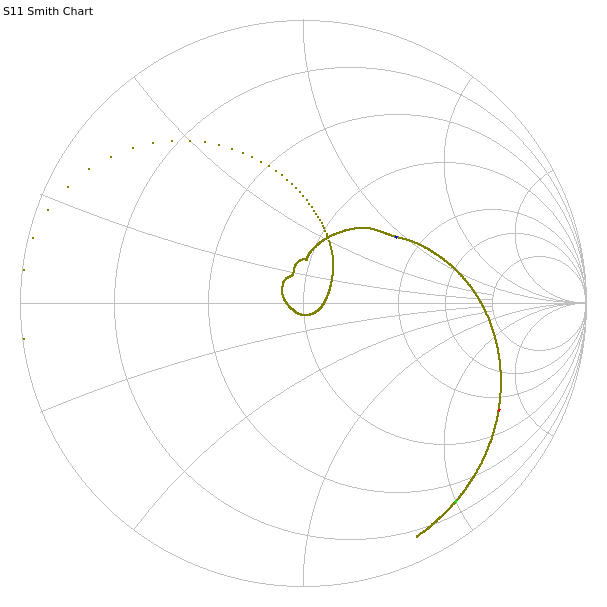
Here is the complex impedance in rectangular coordinates:
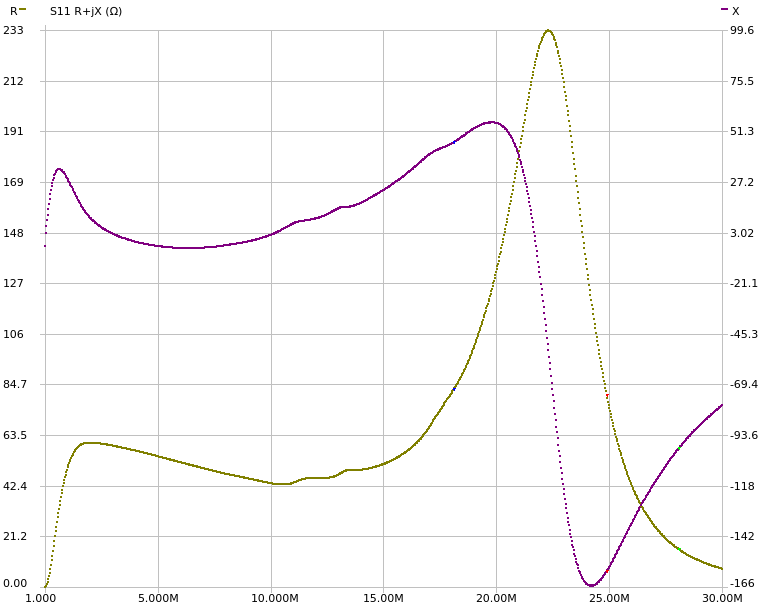
Finally, the SWR is at its lowest (1.085:1) at 7.55 MHz. (Note the different x-axis range.)
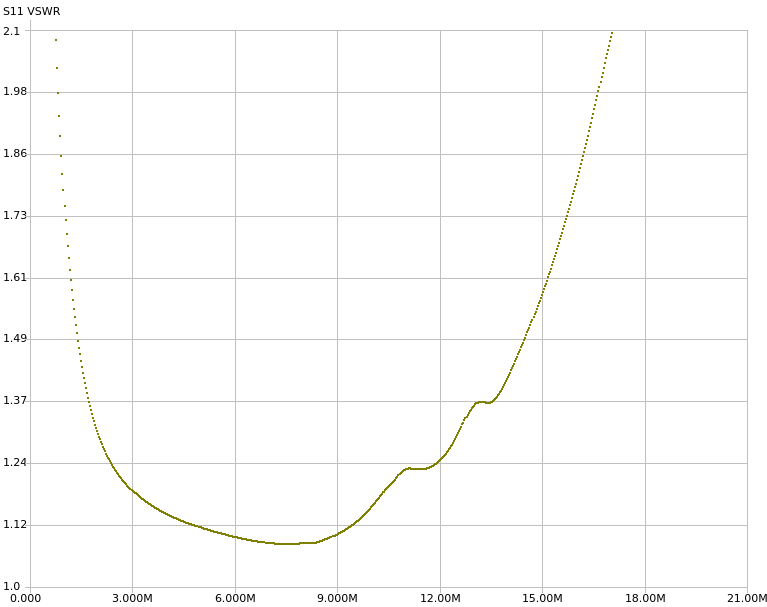
Not perfect, but certainly quite usable. And for those that prefer, here’s a table with various amateur radio HF bands:
| Band | Freq (MHz) | SWR | Z (Ω) | Usable? | |
| 160m | 1.9 | 1.321:1 | 60.4+j11.3 | yes | |
| 80m | 3.6 | 1.159:1 | 58-j0.03 | yes | |
| 60m | 5.3 | 1.111:1 | 54-j3.77 | yes | |
| 40m | 7.1 | 1.086:1 | 49.5-j4.08 | yes | |
| 30m | 10.1 | 1.166:1 | 43.3+j2.41 | yes | |
| 20m | 14.1 | 1.428:1 | 49.2+j17.7 | yes | |
| 17m | 18.1 | 2.345:1 | 82.6+j46.1 | yes | |
| 15m | 21.1 | 3.895:1 | 187+j35.6 | maybe | |
| 12m | 24.9 | 8.341:1 | 80.5-j158 | no | |
| 10m | 28.1 | 16.110:1 | 15.7-j99.7 | no |
Of course, this is with the 3.2kΩ dummy load. The impedances may be completely different with an actual antenna connected.
I mentioned that I went with smaller toroids to make it more portable. The whole unun weighs 161 g (that’s 5.7 funny units, or 0.36 bigger funny units).
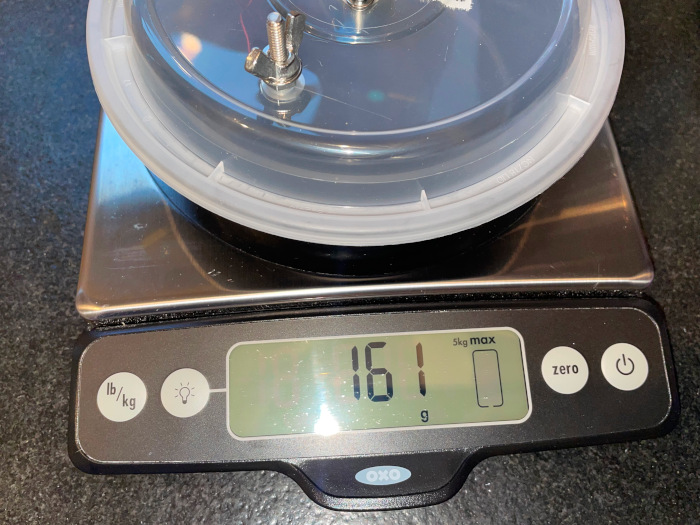
Not super light, but it would have been much worse with 2.4" T240-43 toroids which weigh more than three times as much (106g vs. 33g per toroid).
On-Air Testing
No matter how nice the results of a bench test are, they are irrelevant. What actually matters is on-air performance. So, I packed up my FT-991A, the new unun, and the 40m 1/4 wave antenna’s radiating element (1/4 wave for 40m is the same as 1/2 for 20m) and headed to a nearby park.
I did this two days in a row.
On Saturday (August 13th), I went exclusively with FT4 running 20W. I spent about 1 hour and 12 minutes on-air and got 50 contacts all over Europe, some in North America, and a handful in South America and Africa. A very good activation! (Average: 0.7 contacts/minute)
On Sunday (August 14th), I started with SSB at 66W and later moved to FT4 at 20W. After about an hour and a half and 96 contacts, the SSB pileup kind of dried up, so I switched to FT4 for another hour and a half and another 44 contacts. On SSB, I got only US stations. On FT4, I had a mix of North America and Europe. (Average: 1.04 contacts/minute SSB, 0.5 contacts/min FT4)
Both days, I had the antenna set up as a sloper with the feedpoint (and therefore the unun) about 2 m above ground fed through 100’ of off-brand LMR-240-UF. I know that the repurposed radiating element is too long, but I’ve been too lazy to try to trim it better since the FT-991A’s tuner handles it just fine. The 100’ of coax is completely silly and 20’ would do, but I didn’t have a shorter one handy. The datasheet says that there is 1.60dB loss per 100’ at 30MHz.
With that said, here’s what the NanoVNA showed for the 20m band:
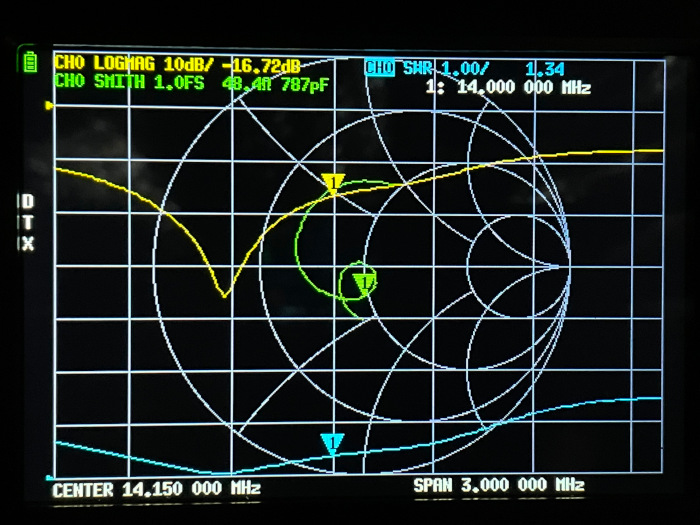
The bottom of the band has SWR of 1.34:1 and the top of the band 1.50:1. The minimum of 1.03:1 is at 13.470 MHz.
For completeness, here’s the 1–30 MHz sweep:
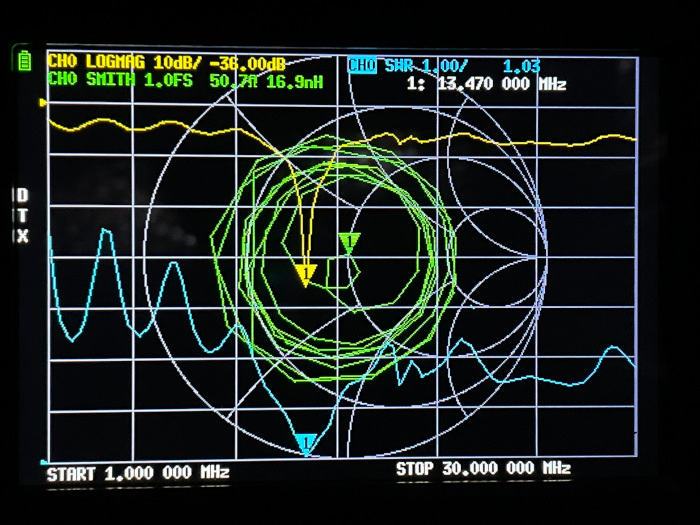
Future Work
Even though I’ve only used the unun for little over 4 hours, I already started collecting todo items for what to check or build next. For example:
- Check the unun temperature after transmitting.
- Possibly move the unun “guts” into a smaller/better box.
- Try making a 64:1 unun (with 24:3 turns) and compare it to this one.
- Consider rebuilding it with a larger gauge magnet wire.
- Cut longer antenna elements and give them a try. Definitely try 80m.
For about $17, I’m very happy with it so far.
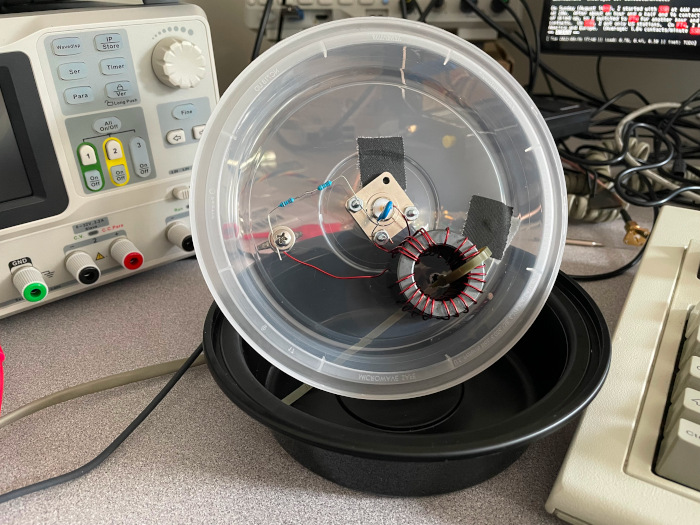
Hi Jeff!
This is a great write up! It seems like the antenna worked great! I noticed you went with an n-connector. I typically build mine with so-239s, but lately have been thinking about using more bnc connectors (and making smaller gear in general). Did you find your swr changed with prolonged use, I am assuming at 100 watts? One of the reasons I built mine with 2 toroids is that I was surpicious that I was saturating mine.
Well, in any case, I enjoyed this article very much and loved the recycled project box!
73s
Mindy
KM1NDY
Comment by Mindy KM1NDY — September 6, 2022 @ 14:05
Thanks!
Yes, the antenna seems to be working well. A couple of weeks ago, we had that major geomagnetic storm and I still got plenty of FT4 and FT8 contacts from EU and NA - which finally got me enough contacts for the Kilo award at Alewife Brook.
When I got into ham radio, I decided to standardize on the Type-N connector. The idea was (and still is) that I don't have to worry about connector losses at VHF and higher - making my coaxes more "general purpose". (Consider that the FT-991A ships with one UHF and one Type-N connector outside of the US.)
I've done 20-30W FT4/FT8 and 66W on SSB. I haven't noticed any SWR change during the ~4 hour activations. I keep forgetting to do a high power test: key down for something like a minute of CW at 50+W and then check the temperature of the toroids.
73
Comment by JeffPC — September 18, 2022 @ 00:14